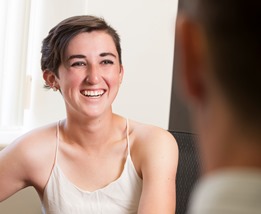
With the help of Rady Children’s Eating Disorder Program, April got her life back. Meet April.
Overview
Rady Children’s Hospital-San Diego and UC San Diego have joined forces to open the Medical Behavioral Unit, the only child and adolescent medical/behavioral inpatient unit in San Diego. The unit treats children and adolescents with medical complications associated with severe malnutrition and pediatric eating disorders. Patients are cared for by a highly experienced team of healthcare professionals with medical, mental health and behavioral health expertise, and specialized experience in treating children’s eating disorders. Our staff includes behaviorally trained nurses, licensed psychiatric technicians, dietitians, psychologists and physicians from our Adolescent Medicine, Hospital Medicine, Medicine/Pediatrics and Psychiatry services. This team is dedicated to providing thorough care, addressing the unique needs of individuals with eating disorders and a focus on behavioral health, nutrition, and overall well-being.
Children and Adolescent Eating Disorders Treatment
Inpatient care is provided by health professionals for children, adolescents, and young adults with eating disorders such as anorexia nervosa, bulimia nervosa, avoidant restrictive food intake disorder, and other related feeding and eating disorders. These patients often have abnormal cardiovascular function or are severely underweight from lack of food and require nutritional rehabilitation and monitoring under expert care for the conditions we treat.
The Eating Disorders Treatment team of healthcare professionals is led by world-renowned authority on eating disorders, Walter Kaye, M.D., professor of psychiatry and director of the UC San Diego Eating Disorders Center for Treatment and Research. Medical treatment for recovery is directed by Kyung (Kay) Rhee, M.D., M.Sc., M.A., professor of pediatrics.
Our children and adolescent pediatric eating disorders treatment and care from health professionals include:
- A complete medical examination and evaluation by an eating disorder specialist, focused on detecting complications of the eating disorder and determining the optimal weight range for each young person/patient. Treatment for unhealthy eating habits will be started for any medical complication, such as severe malnutrition, very low heart rate, low blood pressure, dehydration or abnormal electrolytes. The specialist sees the patient daily and works with the team to make any changes in the treatment plan.
- Dietary assessment by a registered dietitian to facilitate weight restoration and physical health for every young person/patient.
- Fully supervised meals and snacks.
- Behavioral interventions to help patients with nutritional rehabilitation, weight restoration, ending the binge/purge cycle of bulimia, or anxiety and discomfort around eating.
- Therapy, including group therapy, family therapy, and individual therapy, using evidence-based and best-practice treatments, such as dialectical behavioral therapy and family-based therapy for eating disorders.
After patients are stabilized for the eating disorders program, we recommend follow-up for psychiatric/behavioral care at Rady Children’s outpatient psychiatry department or the Partial Hospitalization Program at UC San Diego. Medical follow-up can be arranged with Rady Children’s Adolescent and Young Adult physicians. Your treatment team will work with you and your family to identify an appropriate step-down plan for a strong recovery from the eating disorder.
Contact Us
- If you are concerned for the immediate medical safety of your child or adolescent, please go to your nearest Emergency Room.
- For providers seeking information about medical admissions: please call 858-576-1700 and ask to page the attending physician on call for the Medical Behavioral Unit.
- For families or programs seeking eating disorders treatment program information or general inquiries, please contact the MBU Main line: 858-576-1700, ext. 225368.
In the News
- Anorexia’s Complex Etiology Opens Path to New Treatments, Psychiatric News, features Walter Kaye, M.D.
- How Bulimics’ Brains Are Different, CNN, features Walter Kaye, M.D.
- When Your Child Has an Eating Disorder, Family Circle, features Walter Kaye, M.D.
- Risk for Anorexia Could Be Genetic: Study, NBC Los Angeles, features Walter Kaye, M.D.
- New Insights on Eating Disorders, Monitor on Psychology, features Walter Kaye, M.D.
- Children’s Mental Health Conference Tackles Tough Issues, NBC 7 San Diego, features Walter Kaye, M.D.
- Is There a Link Between Autism and Anorexia? The Atlantic, features Walter Kaye, M.D.
- Bill Would Ban Anorexic Models In California, KPBS, features Walter Kaye, M.D.
- Psychiatry Doesn’t Recognize ‘Orthorexia’ – An Obsession with Healthy Eating. But the Internet Does, The Washington Post, features Walter Kaye, M.D.
- Anorexia May Be Habit, Not Willpower, Study Finds, The New York Times, features Walter Kaye, M.D.
- Eating-Disorders Conference Spreads Awareness, Research, The San Diego Union-Tribune, features Walter Kaye, M.D.